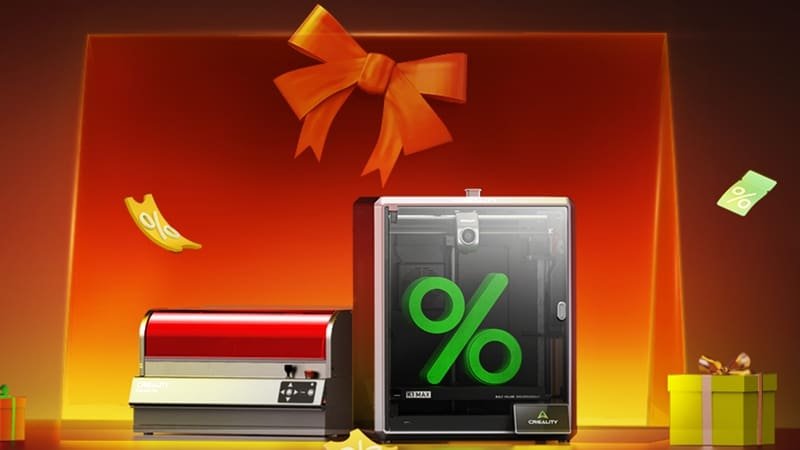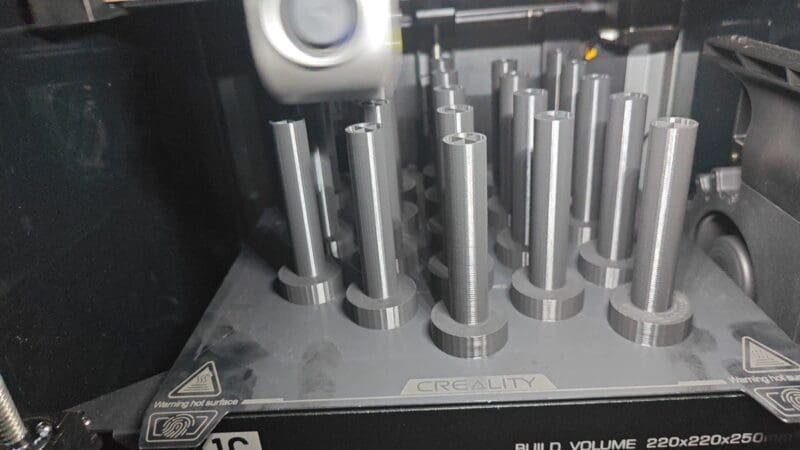7 Tips for Improving Model Print Quality of FDM 3DPrinter
FDM 3D printing technology significantly depends on the type of filament used, as each filament possesses distinct properties and performance characteristics. Selecting the appropriate filament for your specific application is essential.
Let’s delve into the most common types of filaments: PLA, PETG, TPU, ABS, ASA, and various composite materials, highlighting their advantages and disadvantages.
- PLA: Polylactic acid, environmentally friendly, biodegradable, and non-toxic. It is easy to print, has moderate strength, but poor heat resistance (deforms at 60-70 degrees) and is not UV resistant. Suitable for indoor items and toys. Types of PLA include standard PLA, high-speed PLA, aesthetic PLA, etc.
- ABS: An engineering plastic with high strength and heat resistance (90-100 degrees), suitable for structural parts and functional models. It emits toxic fumes, so good ventilation is needed. ASA can replace ABS, offering similar performance but is more resistant to corrosion and aging, and emits no harmful gases, making it suitable for outdoor use, although it is more expensive.
- PETG: Good toughness and weather resistance, but poor heat resistance, commonly used in beverage bottles.
- TPU: Flexible filament, the lower the number, the softer the material, which increases printing difficulty.
- PA: Nylon, with high toughness, heat resistance, and wear resistance, suitable for gears and tooling fixtures.
- Composite materials: Such as PLA-CF (carbon fiber-reinforced PLA) and PET-GF (glass fiber-reinforced PET), which enhance strength and mechanical properties.

For those new to 3D printing, PLA is a great starting filament because it is easy to use, presents few printing challenges, and delivers high print quality. It’s wise to buy filaments from well-known brands since they are thoroughly tested and usually optimized for compatibility with different 3D printers, like eSUN and Polymaker.
Many printer manufacturers test their devices with specific filament brands, which helps ensure better print quality and minimizes potential issues.
Setting Parameters for Third-Party Filaments
When using third-party filaments, it is crucial to fine-tune your printer settings to achieve the best print quality. Different filament types and brands can have unique properties, necessitating specific adjustments for optimal results. While standard slicing settings generally work for PLA, PETG, and ABS, it’s important to adjust the maximum volumetric speed to prevent issues such as oozing, stringing, and clogs.
For example, the fllowing picture shows how to set maximum volumetric speed in OrcaSlicer software. Composite materials like PA-CF and PET-GF require more precise and specific settings due to variations in their manufacturing quality and processes. Consulting the filament manufacturer’s guidelines for recommended settings and adjustments is highly beneficial.
Many manufacturers also provide pre-configured profiles for popular slicing software, ensuring optimal settings for their filaments. Conducting small test prints to fine-tune these settings can further help in achieving the best results with third-party filaments.

Support Structures and Tips
FDM printing builds objects layer by layer, so overhangs and unsupported surfaces require support structures to prevent sagging and deformation. Properly generating and configuring supports is crucial for achieving high-quality prints. Here are some tips and strategies for managing support structures:
Automatic Support Generation
Most slicing software offers automatic support generation, which detects overhangs and unsupported areas and generates supports accordingly. This feature is convenient for beginners, as it simplifies the process of adding supports. However, automatic supports may not always be optimal, so reviewing and adjusting them manually can improve print quality.
Types of Supports
There are two main types of supports: tree-like and linear. Tree-like supports are ideal for complex, organic shapes like figurines and sculptures, as they branch out and provide support with minimal material usage. Linear supports are better suited for geometric models and structures with straight edges. Choosing the appropriate support type can reduce material waste and improve the ease of support removal.
Reducing Contact Area
Minimizing the contact area between the supports and the model reduces the risk of damaging the model’s surface during support removal. Adjusting the support density and pattern in the slicing software can help achieve this. Lower density supports use less material and are easier to remove but may not provide sufficient support for very large overhangs.
Manual Support Placement
For advanced users, manually placing supports can provide better control over the support structure. This approach allows you to add supports only where necessary, reducing material usage and improving surface quality. Most slicing software enables manual support placement, giving you the flexibility to fine-tune the support layout.


Infill Density and Patterns
Infill density and patterns play a crucial role in determining the strength, weight, and material usage of printed parts. Here are some considerations for optimizing infill settings:
- Infill Density:
Infill density is the percentage of the internal volume of the model that is filled with material. Lower infill densities (10-20%) are suitable for decorative items and low-stress applications, reducing material usage and print time. Higher infill densities (30-50%) provide greater strength and durability for functional parts and mechanical components.
- Infill Patterns:
The infill pattern affects the internal structure’s strength and printing time. Common infill patterns include grid, honeycomb, lines, and gyroid. Each pattern has unique properties:
- Grid: Provides good strength and is easy to print, suitable for most applications.
- Honeycomb: Offers excellent strength-to-weight ratio and material efficiency, ideal for lightweight, strong parts.
- Lines: Simple and fast to print, but may not provide as much strength as other patterns.
- Gyroid: Complex but provides excellent isotropic strength, making it ideal for parts that need uniform strength in all directions.
- Adjusting Infill Settings:
Fine-tuning infill settings can optimize print strength and efficiency. For instance, increasing the number of top and bottom layers can enhance surface quality and strength, while adjusting the infill overlap with the outer walls can improve adhesion between the infill and the model’s shell.
- Adaptive Infill:
Some slicing software offers adaptive infill options, which adjust the infill density dynamically based on the model’s geometry. This approach can reduce material usage and print time while maintaining structural integrity in critical areas.
Model Orientation and Its Impact on Printing
The orientation of the model on the print bed significantly affects print quality, strength, and support requirements. Properly orienting the model can minimize supports, improve surface quality, and enhance the part’s mechanical properties. Here are some tips for optimizing model orientation:
- Minimize Overhangs and Supports:
Orient the model to reduce overhangs and the need for supports. For example, rotating a model with large overhangs to lay flat on the bed can eliminate the need for extensive supports. This approach saves material, reduces print time, and improves surface quality.
- Surface Quality:
The orientation affects the quality of the visible surfaces. To achieve the best surface finish, orient the most critical surfaces to face upwards or horizontally. This minimizes the layer lines and artifacts that can appear on vertical surfaces.
Types and Differences of Print Beds
The print bed type significantly affects print adhesion, surface finish, and ease of model removal. Common print beds include PEI-coated, PC film-coated, and glass-coated beds. Each type has unique characteristics:
- PEI-Coated Beds:
PEI (polyetherimide) beds offer excellent adhesion for various filaments. When heated, they provide strong adhesion, preventing warping and lifting. As the bed cools, models typically detach easily. PEI-coated beds come in textured and smooth variants. Textured PEI beds leave a textured finish on the model’s bottom, while smooth PEI beds result in a glossy finish.
- PC Film-Coated Beds:
PC (polycarbonate) film-coated beds offer good adhesion for most filaments and are particularly effective for materials like PLA and PETG. These beds are less prone to wear and provide a smooth surface finish. However, they may require adhesive aids, like glue sticks or hairspray, for certain filaments to improve adhesion.
- Glass-Coated Beds:
Glass beds provide a flat, smooth surface that can enhance the bottom layer’s finish. They are compatible with various adhesives and can be used with materials like PLA, PETG, and TPU. However, glass beds may require higher bed temperatures and additional adhesion aids for materials prone to warping, like ABS.
Choosing the right print bed depends on the filament type, model requirements, and personal preferences. For instance, the Flashforge Adventurer 5M series offers different print bed options, allowing users to select the best one for their needs.

Note: This sheet is from flashforge Facbook page.
Solving Warping and Adhesion Issues
Warping is a common issue, especially with large base areas and sharp corners. Enable the brim feature in slicing software, increase the first layer height, and reduce the first layer print speed to enhance adhesion.
For smooth print beds, apply glue before printing. For engineering filaments like ABS and ASA, even with an enclosure, uniform chamber temperatures are needed to prevent warping and cracking. Preheat the bed to warm the chamber if no active heating system is available. Clean the PEI bed with water to remove oils and dust, improving adhesion. Avoid using alcohol, as it can damage the coating.
Additional Printing Tips
Filaments can absorb moisture from the air, leading to poor print quality and defects like stringing and bubbling. Store filaments in airtight containers with desiccants to keep them dry. For particularly hygroscopic filaments like nylon, using a filament dryer before printing can ensure optimal results.
When printing PLA, keep the enclosure door open to avoid overheating and filament softening, which can lead to clogs. After cooling, models on a PEI bed will usually detach automatically. Avoid removing prints from a hot bed to prevent damage. If prints do not detach after cooling, flex the bed or use a spatula to assist.
By following these tips and best practices, you can significantly improve the quality of your FDM 3D prints, reduce common issues, and achieve consistent, high-quality results.
DISCLOSURE: THIS POST MAY CONTAIN AFFILIATE LINKS, MEANING I GET A COMMISSION IF you DECIDE TO MAKE A PURCHASE THROUGH MY LINKS, AT NO COST TO YOU. PLEASE READ MY DISCLOSURE FOR MORE INFO.



